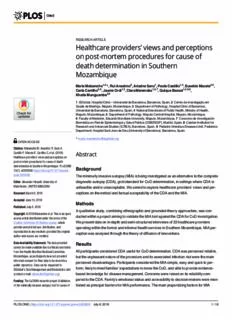
Healthcare providers' views and perceptions on post-mortem procedures for cause of death PDF
Preview Healthcare providers' views and perceptions on post-mortem procedures for cause of death
RESEARCHARTICLE Healthcare providers’ views and perceptions on post-mortem procedures for cause of death determination in Southern Mozambique MariaMaixenchs1,2*,RuiAnselmo2,AriadnaSanz1,PaolaCastillo1,3,EusebioMacete2,4, CarlaCarrilho5,6,JaumeOrdi1,3,ClaraMenendez1,2,7,QuiqueBassat1,2,8,9, KhatiaMunguambe2,6 a1111111111 a1111111111 1 ISGlobal,HospitalClinic—UniversitatdeBarcelona,Barcelona,Spain,2 CentrodeInvestigac¸ãoem Sau´dedeManhic¸a,Maputo,Mozambique,3 DepartmentofPathology,HospitalClinicofBarcelona, a1111111111 UniversitatdeBarcelona,Barcelona,Spain,4 NationalDirectorateofPublicHealth,MinistryofHealth, a1111111111 Maputo,Mozambique,5 DepartmentofPathology,MaputoCentralHospital,Maputo,Mozambique, a1111111111 6 FacultyofMedicine,EduardoMondlaneUniversity,Maputo,Mozambique,7 ConsorciodeInvestigacio´n Biome´dicaenReddeEpidemiolog´ıaySaludPu´blica(CIBERESP),Madrid,Spain,8 CatalanInstitutionfor ResearchandAdvancedStudies(ICREA),Barcelona,Spain,9 PediatricInfectiousDiseasesUnit,Pediatrics Department,HospitalSantJoandeDe´u(UniversityofBarcelona),Barcelona,Spain *[email protected] OPENACCESS Citation:MaixenchsM,AnselmoR,SanzA, CastilloP,MaceteE,CarrilhoC,etal.(2018) Abstract Healthcareproviders’viewsandperceptionson post-mortemproceduresforcauseofdeath determinationinSouthernMozambique.PLoSONE Background 13(7):e0200058.https://doi.org/10.1371/journal. pone.0200058 Theminimallyinvasiveautopsy(MIA)isbeinginvestigatedasanalternativetothecomplete Editor:AlexanderHeazell,Universityof diagnosticautopsy(CDA),goldstandardforCoDdetermination,insettingswhereCDAis Manchester,UNITEDKINGDOM unfeasibleand/orunacceptable.Weaimedtoexplorehealthcareproviders’viewsandper- Received:March9,2018 ceptionsontheoreticalandfactualacceptabilityoftheCDAandtheMIA. Accepted:June15,2018 Methods Published:July6,2018 Aqualitativestudy,combiningethnographicandgrounded-theoryapproaches,wascon- Copyright:©2018Maixenchsetal.Thisisanopen ductedwithinaprojectaimingtovalidatetheMIAtoolagainsttheCDAforCoDinvestigation. accessarticledistributedunderthetermsofthe CreativeCommonsAttributionLicense,which Wepresentdataonin-depthandsemi-structuredinterviewsof33healthcareproviders permitsunrestricteduse,distribution,and operatingwithintheformalandinformalhealthservicesinSouthernMozambique.MIAper- reproductioninanymedium,providedtheoriginal ceptionwasanalysedthroughthetheoryofdiffusionofinnovations. authorandsourcearecredited. DataAvailabilityStatement:Thedataprovided Results cannotbemadeavailableduetoethicalconstraints fromtheHealthBioethicsNationalCommittee, AllparticipantsconsideredCDAusefulforCoDdetermination.CDAwasperceivedreliable, Mozambique,asparticipantshavenotprovided buttheunpleasantnatureoftheprocedureanditsassociatedinfectionriskwerethemain informedconsentfortheirdatatobestoredina perceiveddisadvantages.ParticipantsconsideredtheMIAsimple,easyandquicktoper- publicrepository.Datacanberequestedto form;likelytomeetfamilies’expectationstoknowtheCoD,andabletoprovideevidence- ISGlobal’sDataManagementandBiostatisticsUnit (contacte-mail:[email protected]). basedknowledgefordiseasemanagement.Concernswereraisedonitsreliabilitycom- paredtotheCDA.Family’semotionalstatusandaccessibilitytodecision-makersweremen- Funding:TheCaDMIAresearchproject(Validation oftheminimallyinvasiveautopsytoolforcauseof tionedasprincipalbarriersforMIAperformance.ThemainjeopardizingfactorsforMIA PLOSONE|https://doi.org/10.1371/journal.pone.0200058 July6,2018 1/16 Healthcareproviders’viewsonpost-mortemmethodsinMozambique deathinvestigationindevelopingcountries)was implementationweretheshortageofrequiredresourcesandthesignificantproportionof fundedbytheBill&MelindaGatesFoundation peopledyingathome.KeyfacilitatorsforMIAacceptanceincludedtheneedforthesupport (GlobalHealthgrantnumbersOPP1067522;QB) fromcommunityandreligiousleaders,provisionofclearinformationtothecommunity,and (http://www.gatesfoundation.org/)andbythe SpanishInstitutodeSaludCarlosIII(FIS,PI12/ accompanimenttobereavedfamilies. 00757;CM)(https://portalfis.isciii.es).Data analysishasbeensupportedbytheCaDMIAplus Conclusions researchproject,fundedbytheBill&Melinda GatesFoundation(Globalhealthgrantnumbers HealthcareprovidersconsidertheMIAspotentiallymoreacceptableandfeasiblethan OPP1128001;JO)(http://www.gatesfoundation. CDAsinplaceswherethelatterhaveshownsignificantimplementationchallenges.Aclear org/)andtheSpanishInstitutodeSaludCarlosIII (AccionesCIBER;CM)(http://www.ciberisciii.es/). understandingofhealthcareprovider’sperceivedbarriersandfacilitatorsforconducting QBhasafellowshipfromtheInstitucio´Catalanade post-mortemproceduresingeneral,andMIAsinparticular,willshedlightontheirfuture RecercaIEstudisAvanc¸ats(ICREA)agency fieldimplementationformorerobustmortalitysurveillance. (cid:3)(https://www.icrea.cat/)(cid:3)<https://www.icrea.cat/>. ISGlobalisincludedintheCERCAProgramme/ GeneralitatdeCatalunya(http://cerca.cat/en/suma/ ).Thefundershadnoroleinstudydesign,data collectionandanalysis,decisiontopublish,or preparationofthemanuscript. Introduction Competinginterests:Theauthorshavedeclared thatnocompetinginterestsexist. Inlowandmiddle-incomecountries(LMIC),significantchallengesexistinordertoaccount forandestablishwhatthemaincausesofdeathattheindividualandpopulationlevelare. Althoughmuchstrongerrecommendationsarenowinplacetostrengthenvitalregistration systemsinthesesettings,therealityisthatinmanyruralareasofthepoorestcountries,acon- siderablenumberofbirthsanddeathsarenotcapturedbythenationalregistrationplatforms. Insub-SaharanAfrica,regionaldeathcertificatecoveragemaybeaslowas10%,andthequal- ityofcauseofdeathdataremainspoor,essentiallyrelyingonverbalautopsyandclinicaldata [1].Mozambique,aparadigmaticexampleofasub-SaharanAfricancountryisnoexceptionto this,wherebymortalitydataarescarce,incompleteandoftenunreliable[2]. Theminimallyinvasiveautopsy(MIA)hasbeenvalidatedasastrongalternativeforcause ofdeathdetermination(CoD)inLMICwherethegoldstandardmethod,thecompletediag- nosticautopsy(CDA),isunfeasibletoimplement[3–6].Insuchcountries,CDAcanonlybe performedintop-levelhealthfacilities,whereasinthecommunityverbalautopsiesarethe commonlyusedmethodforCoDdetermination.However,VAhasimportantlimitationsand poorspecificity[7]. TheMIAconsistsofaseriesofpost-mortempuncturesusingbiopsyneedlesaimingto obtaintissuesamplesandbodyfluidswithinthefirsthoursafterdeath,whicharethensubmit- tedforathoroughhistopathologicalandmicrobiologicalinvestigationoftheunderlyingCoD [8].ThevalidationofthisnewMIAprotocolforCoDinvestigationinLMIChasbeencon- ductedinMozambique,inahead-to-headcomparisonagainstthegoldstandardmethodology, theCDA.Theresultshaveshown,inthedifferentagegroupsstudied,includingadults,chil- dren,neonates,stillbirthsandmaternaldeaths,amoderatetosubstantialconcordancebetween thetwomethods(Kappavaluesoftheconcordanceanalysesinthedifferentagegroupsrang- ingfrom0.40to0.78)[3–6].Therefore,theMIAcanpotentiallyactasanalternativeforthe CDAinthoseareaswherethelattercannotbeeasilyconducted,providedthattheprocedureis acceptednotonlybythecommunitybutalsobyhealthcareproviders. Healthcareprovidersareregularlyincontactwiththeeventofdeathandareoftenres- ponsiblefortheinteractionwiththerelativesofdyingordeadindividuals(includinggrief counsellingandconsentforpost-mortemprocedures).Additionally,someofthesehealthpro- fessionalsmaybepotentialcandidatestoperformtheMIAinthefuture.Previousqualitative studiesabouthealthproviders’perceptionsandattitudesrelatedtopost-mortemmethodsand PLOSONE|https://doi.org/10.1371/journal.pone.0200058 July6,2018 2/16 Healthcareproviders’viewsonpost-mortemmethodsinMozambique communicationwithbeaveredfamilies(includinginformedconsent)aremainlyfocusedon High-IncomeCountries(HIC)[9–12]. Inthisanalysisweaimedtoexplorelocalhealthcareproviders’perceptionsandattitudes regardingpost-mortemmethodsingeneral,andMIAsinparticular,andtheperceivedadvan- tages,disadvantages,barriersandfacilitatorsofthistechniqueinthecontextoflowresourced settings.Thetheoryofdiffusionofinnovations(DOI)introducedin1962byRogers[13]is usefultounderstandwhyandhowrapidlynewtoolsandinterventionsareadopted(ornot), despitetheevidenceoftheirpotentialbenefits[14].TheDOIfocusesonthemultiplefactors thatcanaffectanyimplementation,takingintoconsiderationtheinnovationitself,thecom- municationchannelsandthedecision-makingprocesses,timeandthesocialsystems[13]. Methods Studysiteandpopulation ThestudytookplaceinMaputocityandintheDistrictofManhic¸a,bothinSouthernMozam- bique.Maputo,thecapitalofMozambique,isacitywithapopulationofapproximately2mil- lionpeople,mostofthemlivinginperi-urbanareas.ThecityisservedbytheMaputoCentral Hospital(HCM),whereCDAsareroutinelyconducted,aswellasthreegeneralhospitalsand severalhealthfacilities.BesidesconductingroutineCDAs,fromNovember2013toMarch 2015,theHCMhostedaMIAvalidationstudy,inwhich282MIAswereperformedonadults (includingmaternaldeaths),children,neonatesandstillborndeceasedatthehospital,and comparedagainstCDAsasthegoldstandard[3–6]. Manhic¸aDistrictisaruralarea,located80KmnorthofMaputoCity,withapopulationof 183,000inhabitantscoveredbyaHealthandDemographicSurveillanceSystem(HDSS)ranby theManhic¸aHealthResearchCentre,previouslydescribedelsewhere[8,15].Healthservicesin Manhic¸aDistrictareprovidedbyadistricthospital,aruralhospital,and12primary-level healthcenters,nonewiththecapacitytoconductpost-mortemproceduresatthetimewhen thecurrentstudywasconducted[8]. FormalandinformalhealthsystemstructurescoexistbothinMaputoandinManhic¸a. Informalhealthcareprovidersinclude,amongothers,traditionalhealers,herbalists,traditional birthattendants,informaldrugprovidersandknowledgeableelders.Thetargetpopulationof thisspecificanalysisincludedhealthcareprovidersfrombothgeographicalareas,definedas thoseregularlyincontactwithdeathevents,bothwithintheformalandinformalhealthsys- tem,andinvolvedornotinpost-mortemprocedures(includingtheperformanceofMIAs). Thisincludedmedicaldoctors,nurses,midwives,communityhealthworkers(CHW),tradi- tionalbirthattendants(TBA)andtraditionalhealers. Studydesign Thisarticlereportsfindingsfromaqualitativestudyconductedinthecontextofalargermulti- centrestudy[ValidationoftheMinimallyInvasiveAutopsytoolforcauseofdeathinvestiga- tionindevelopingcountries(CaDMIA)],aimingtoassesstheperformanceofaminimally invasiveautopsytool(MIA)incomparisontotheCDA[3–6].Theoverallqualitativecompo- nent,conductedin5countries(Gabon,Mali,Kenya,Mozambique,Pakistan),wasbasedona combinationofethnographic[16]andgroundedtheory[17,18]approachestodatacollection andanalysis.Theaimwastounderstandthephenomenonofdeathandpost-mortemmethods fromthelocalcommunitiesperspectives(includinghealthcareproviders),andtocontributeto theorybasedondatasystematicallyobtainedfromsocialresearch[17,18].Inconsequence, therewerenopredeterminedspecifichypotheses,butbroadresearchquestionsfocusedonthe areaofinterest.Theresearchquestionsaddressedbythisspecificstudy,focussedonlyin PLOSONE|https://doi.org/10.1371/journal.pone.0200058 July6,2018 3/16 Healthcareproviders’viewsonpost-mortemmethodsinMozambique Mozambicanhealthcareproviders,included:i)HowdohealthcareprovidersperceiveCDAs andMIAs?ii)Whatarethebarriers,facilitatorsandrequirementsforMIAimplementation accordingtohealthcareprovidersinSouthernMozambique? Sampling Aminimumsamplesizeof30participantswasdefinedbasedonsimilarstudies’experiencein reachingsaturation(thenon-additionofnewconceptsafterthecontinuousrecruitmentof moreinterviewees)[19,20].Purposivesamplingwasusedtoonlyenrolthosewhowereregu- larlyincontactwithdeath(particularlycorpsesandbereavedfamilymembers),specificallyat thetimeofdeathand/orshortlyafterthedeathevent.Thoseincludedwereformalhealthcare providers(medicaldoctors,nurses,clinicalofficers,midwifes,healthfacilityadministrative personnel,stafffromthehealthfacilitymorguesandcommunityhealthworkers),andinfor- malhealthcareproviders(traditionalbirthattendantsandtraditionalhealers).Ofnote,some oftheinterviewedhealthcareprovidersinMaputohadactuallywitnessedCDAsandMIAs beingconducted,whilethoseinterviewedinManhic¸ahadgenerallyneverseenpost-mortem techniquesbeingconductedandthus,theirperceptionswerediscussedfromatheoretical pointofview. Recruitmentstrategy Formalhealthcareproviderswereidentifiedandrecruitedathealthfacilitiesbythestudysocial scientistsandresearchassistants.Informalhealthcareproviderswereidentifiedandrecruited byresearchassistantsthroughaseriesofcommunitymeetingsthatwereheldtoexplainthe CaDMIAethnographicstudywithinthestudyarea[8]. Datacollection Thirty-threesemi-structuredinterviewswereconductedwithhealthcareproviders(inrural Manhic¸aandurbanMaputo)betweenNovember2013andFebruary2015.Datawerecollected bysocialscientistsandlocalresearchassistantsbasedonaguideofopenquestionslinkedto themainresearchquestions,butalwaysfocusingontherespondents‘trainofthoughts”,allow- ingemergingthemestobecaptured.InterviewswereconductedinShangaanorPortuguese, accordingtoparticipant’spreference,wereaudiorecorded(whenpermissionwasgivenby participants)andtranscribed.Detailedfieldnotesweretakenwhennopermissionwasgiven forrecording. Analysis Whiletheoverallqualitativestudyusedgroundedtheory,datafromthisspecificcomponent werethematicallycodedusingNvivo10(QSRInternationalPtyLtd).Thiscodingprocess entailsidentifyingpassagesoftextrelatedtothetopicsofinteresttotheresearchquestionand labellingthemwithspecificthemesandsub-themes.Astranscriptsweregraduallyimported intotheNvivoprojectandthoroughlyread,codeswererefined,addedoreliminated,depend- ingontheirrelevancetothemainresearchquestion,thealreadycodeddata,andtheemergent data.Bygroupingtogethersimilarlycodedtext,themeswereconstructed,discussionswere builtaroundeachthemeandaroundlinksbetweenthemesandsubthemes,andfromthesedis- cussions,themainconclusionsemerged[21]. Thetheoryofdiffusionofinnovations(DOI)[13],wasusedtoassesMIAsperceptions fromthestandpointofaninnovation.Diffusionofinnovationsistheprocessbywhichanew idea,practice,orobjectthatisperceivedasnew,iscommunicatedthroughcertainchannels PLOSONE|https://doi.org/10.1371/journal.pone.0200058 July6,2018 4/16 Healthcareproviders’viewsonpost-mortemmethodsinMozambique overtimeamongthemembersofasocialsystem.Thecharacteristicsofinnovations,asper- ceivedbyindividuals,helptoexplaintheirdifferentrateofadoption.Theanalysisfocuseson the5characteristicsorelements,describedinthetheory,namelyi)relativeadvantage;ii)com- patibility;iii)complexity;iv)trialability;andv)observability[13]. ThisstudycomplieswiththeConsolidatedCriteriaforReportingQualitativeResearch (COREQ)checklist[22]. Ethicalconsiderations ThestudywasapprovedbytheManhic¸aHealthResearchCentre’sInstitutionalReviewBoard (CIBS-CISM)andtheMozambicanNationalBioethicsCommittee(Ref.342/CNBS/13)in Mozambique,andbytheEthicsCommitteeofBarcelona’sHospitalCl´ınic(File2013/8676)in Spain.Writteninformedconsentwasobtainedfromallparticipants.Inthecaseofilliteracy, participantsprovidedathumbprintthatwascountersignedbyanimpartialwitness,guarantee- ingthatparticipationhadbeeninformedandvoluntary.Alldataweremanagedbasedon uniqueidentificationnumberssoastoguaranteetherespondent’sanonymity. Results Atotalof33respondentswereinterviewed,39%(13/33)inMaputoand61%(20/33)inthe Manhic¸astudyarea.Fifty-eightpercent(19/33)ofallparticipantsweremales,67%(22/33) hadcompletedprofessionaltrainingorfurtherstudies,andthemajority(79%;26/33)was Christian.Detailedsocio-demographiccharacteristicsofthestudyparticipantsareshownin Table1.Allwhomwereapproachedbythestudyteamacceptedtoparticipate. Table1. Socio-demographiccharacteristicsofparticipantsandexperiencewithcompletediagnosticautopsies andminimallyinvasiveautopsies. Participants MaputoCity Manhic¸aDistrict TOTAL n(%) n(%) N(%) Gender Male 9(69) 10(50) 19(58) Female 4(31) 10(50) 14(42) Agegroup,years 18–29 5(38) 2(10) 7(21) 30–49 7(54) 10(50) 17(52) >50 1(8) 8(40) 9(27) Education Noschooling 0(0) 0(0) 0(0) Primary1 3(23) 8(40) 11(33) Secondary 0(0) 0(0) 0(0) ProfessionalTraining 2(15) 11(55) 13(40) Universityorhigher 8(62) 1(5) 9(27) Occupation MedicalDoctor 6(46) 1(5) 7(22) Clinicalofficer 2(15) 4(20) 6(18) Nurse 0(0) 3(15) 3(9) Midwife 0(0) 2(10) 2(6) Pathologyassistant 2(8) 0(0) 1(3) HospitalRegistrar 0(0) 1(5) 1(3) Mortuaryassistant 3(23) 1(5) 4(12) (Continued) PLOSONE|https://doi.org/10.1371/journal.pone.0200058 July6,2018 5/16 Healthcareproviders’viewsonpost-mortemmethodsinMozambique Table1. (Continued) Participants MaputoCity Manhic¸aDistrict TOTAL n(%) n(%) N(%) Communityhealthworker 0(0) 2(10) 2(6) Traditionalbirthattendant 0(0) 3(15) 3(9) Traditionalhealer 0(0) 3(15) 3(9) Religion Christian2 9(69) 17(85) 26(79) Muslim 1(8) 1(5) 2(6) Animist 0(0) 2(10) 2(6) Atheist 1(8) 0(0) 1(3) Unknown 2(15) 0(0) 2(6) Experiencewithpostmortemprocedures Hasconducted/seenCDA Yes 12(92) 7(35) 19(56) No 1(8) 13(65) 14(42) Hasconducted/seenMIA Yes 6(46) 0(0) 6(18) No 7(54) 20(100) 27(82) TOTAL 13(39) 20(61) 33(100) Valuesaren(percent)unlessindicatedotherwise 1Includesthreeparticipantswithincompleteprimarystudies 2IncludesCatholic,ProtestantorEvangelist,orChristianundetermined. https://doi.org/10.1371/journal.pone.0200058.t001 ViewsandperceptionsofhealthcareprovidersregardingComplete DiagnosticAutopsies(CDA) TwelveoftheparticipantsfromMaputo(12/13)hadbeeninvolvedintheperformanceofat leastoneCDA.Allbuttwo(11/13)wereworkingattheMaputoCentralHospital,ofwhichsix (6/11)conductedCDAsaspartoftheirroutineactivities.NoCDAswereperformedinMan- hic¸a,wherelessthanhalfoftheparticipants(7/20)reportedanypreviousparticipationin post-mortemmethods,alwaysinthecontextoftheirprofessionaltraining. ParticipantsfromMaputoexplainedthattheCDAisaprocedureconsistinginopeningthe body,conductingavisualexaminationoftheorgans,collectingsamplesforhistologyand, finally,stitchingtheincisions.Thedescriptionalsoincludeddetailsonthenatureandlocaliza- tionoftheincisions,themainorgansobserved,andthematerialused. AmongformalhealthcareprovidersfromtheManhic¸aarea,theCDAwasdefinedasatech- niqueconsistinginopeningthebody,exploringtheorgansandobtainingsamplesforanalysis. NeitherthethreeCHWsnortheinformalproviders(threeTBAandthreetraditionalhealers) wereabletoexplaintheprocedure.AtraditionalhealerreferredtotheCDAastheopeningof thehead. SomeparticipantsexplainedthattheCDAwasnoteasytoperform,unpleasant,andcaused physicalandmentaldiscomforttothestaffperformingit.Additionally,itwassaidthatspecial- izedtrainingwasneededtoconductaCDAsandthatthestaffinchargehadtobepsychologi- callypreparedtofacetheprocess.Thestrongsmell,thelargeincisions,theexposuretothe organsandthebloodwereothermentioneddisturbingissues. Participantsalsoexpressedconcernsregardingreturningasignificantlydisfiguredbodyto thefamilies,anditsimpactontheiremotions,aggravatingtheexistingshockfromthedeathof PLOSONE|https://doi.org/10.1371/journal.pone.0200058 July6,2018 6/16 Healthcareproviders’viewsonpost-mortemmethodsinMozambique abelovedone,andcausingadditionalstress.Healthprovidersreportedthediscomfortrelated torequestingconsentorinformingthefamiliesaboutCDAs,particularlyifinfluencedby rumorsabouttheprocedure,althoughfamiliesnormallywereopentoreceivinginformation aboutthemethodandthereasonsforrequestingtheCDA. “Theyjusthaveheardofit(CDAs)fromothers.That’s whytherearesomepeoplewhoreject theautopsy(CDA)buttheydonotknowreallywhatitis,theythinkautopsy(CDA)istotake organsawaytobestoredforstudyingthem.Itisastheyweretakinghomeanemptybody.” Medicaldoctor,36yearsold,female OneofthemajorconcernsregardingCDAsamonghealthprofessionalswithexperienceof CDAperformancewastheriskofinfection. “There(whendoingautopsies)theriskis...Sometimes,well,mostofthetime,weworkwith seropositive(HIVpositive)bodies,soonecanneverbetoocareful.”Pathologyassistant,27 yearsold,male Despitetheabovementionedconcerns,themajorityofformallytrainedhealthprofessionals consideredthattheCDAwasausefultoolforgettingtoknowtherealCoD,especiallywhenit wasnotclear,andthatlearningfromtheresultscouldhelpimprovingdiseasemanagement anddiagnosisinthefuture. “[CDA]isawaywehavetoclarifyspecificcausesthat,whenthepersonwasalive,wewerenot abletoidentify.(...)Ontheotherhand,wemayhavethoughtwewereinfrontofacertain diseaseandwhenwehavetheresultsfromhistology,fromtheautopsy,itrevealsotherthings, andsoweenduplearning.Yes, weenduplearning.”Medicaldoctor,35yearsold,female. “ThefirsttimeIsaw(aCDA)itwasreallyshocking.Butafterthis,Irealizeditwasnecessary toknowtherealcauseofdeath.We sawischemiacases.Thosethingsgounnoticed,youjust discoverthemwhentheheartisdirectlyobservedandyoucanseethechangesoccurringinthis organ.”Medicaldoctor,33yearsold,female However,healthprofessionalswerealsoawarethatpostmortemexaminationscouldeluci- datetherealunderlyingCoD,potentiallyquestioningtheclinician’sdiagnosticandprognostic capacity. “Iamafraidpeoplewillsay“no” [toCDA],becausewhenyouexplaintothefamilythatyou wanttodotheautopsy,thatyouwanttoconfirm,todiscoverthecauseofdeath...the patients,whentheycometoyou,theyexpectyoutoknow.So,conveytothemtheideathat“I donotknow”,“wedonotknow”isdifficult.”Medicaldoctor,38yearsold,female. Finally,someparticipantsexplainedthathealthprofessionals’negativeconnotationsto CDAsshouldbedemystifiedthrougheducationandinformation.Workingatthepathology departmentoratthemortuaryoftheMaputoCentralHospitalinvolvedstigmatization, accordingtosomeparticipants,particularlyforassistantsandmortuarypersonnel.Oneof themrevealedthatpathologydepartmentandmortuarystaffmemberswereuncomfortable withdisclosingtheirprofessionordetailsofworkplace(i.e.,thepathologydepartmentorthe mortuaryservices)because,otherwise,theywouldbeperceivedascrazyordrugaddictsoreven asbadpersons.Thesameparticipantmentionedthat,evencolleaguesfromthesamehospital mighttreatthemdifferentlywhenfindingouttheywereworkinginthisarea. PLOSONE|https://doi.org/10.1371/journal.pone.0200058 July6,2018 7/16 Healthcareproviders’viewsonpost-mortemmethodsinMozambique ViewsandperceptionsofhealthcareprovidersregardingMinimally Invasiveautopsies(MIA) SixparticipantsinterviewedinMaputo(6/13)wereinvolvedinconductingMIAsaspartof theirroutineactivities.AllofthemwerealsofamiliarwithCDAs.AttheManhic¸aarea,nopar- ticipanthadeverseenorparticipatedinaMIA. TheMIAwasviewedbyallparticipants,includingthosewithoutpreviousexperiencewith theprocedure,asasimple,easyandquicktechniquethatanyonecouldperformafterappropri- atetraining.Intheiropinion,theMIAscouldbeperformedanywhere,evenintheabsenceof formalpathologyfacilities,oratthehouseholdlevel. “We (healthprofessionals)needsomethingquick,thatdoesnottakeusalotoftime.So,itis preferablewedoMIA(thanCDA),afteranappropriatetraining.”Clinicalofficer,33years old,male. ParticipantswhohadpreviouslyconductedaMIA,consideredthatthemethodwas cheaper,lessunpleasantandlesstimeconsumingcomparedtoCDAs,withadurationof about30–45minutes,asopposedtothe~2hoursrequiredforCDAs.Concernsdidhowever ariseregardingthecostoftheneedlesandadditionallaboratorytests. ThemainadvantageforthoseperformingMIAwasthatthetechniquedidnotinvolve majorincisions:ononehand,thisallowedtheproceduretobeclean,therewasnobloodand mess,therewaslessdisgustingsmell,andtheriskofinfection(althoughitremainsaserious concern)wasbelievedtobesignificantlylower.Ontheotherhand,returninganapparently intactbodywouldremoveadditionalstresstothefamily,allowthebodytobeshownduring theceremoniesandavoidsuspicionsregardingorgansremoval. “WithMIA,youmanagetodoakindofautopsythatpeopleathomemightnotnotice.I mean,everythingisfine.Becausethewaytheautopsy(CDA)isdone....Itisnotpossibleto openthecoffinandstaythere,seeingthedeceased,thatway...thehead...all...Imean,peo- pleendupcryingtwice.WithMIA,peopledonotnoticethatastudyhasbeendoneandyou mightreachadiagnosisaswell.”Pathologyassistant,38yearsold,male AdisadvantagehighlightedbyintervieweesoftheMIAincomparisontotheCDAwasa potentiallyreducedperformanceofthetoolintermsofreachingadiagnosis,astheprocedure consistsjustontheanalysisofsmallsamplesanddoesnotallowanopen-eyedmacroscopic analysis. “A disadvantage(ofMIA)isthatyoucannotvisualizethewholeorgan.Becausetoreacha diagnosis,insomecases,justforthemerevisualizationofthelesions,wereachthediagnosis.” Medicaldoctor,26yearsold,male. Facilitators,barriersandrequirementsforMIAimplementationfrom healthcareproviders‘perspective TheinterestinknowingtheCoDwasmentionedbyalmostallparticipantsasafacilitatorfor MIAstobeperformedinthefuture.Accordingtohealthcareproviders,familieswouldclearly wanttoknoworclarifytheCoDoftheirdeceasedrelatives.TodiscovertheCoDthroughthe MIAwouldallowtakingmeasuresincaseofcontagiousorfamilydiseases.Further,themere factofknowingthecauseofdeathwouldremoveuncertaintiesaboutthecircumstancesofthe death,includingtheavoidanceofwitchcraftaccusations,provisionofpeace,andreleasefrom PLOSONE|https://doi.org/10.1371/journal.pone.0200058 July6,2018 8/16 Healthcareproviders’viewsonpost-mortemmethodsinMozambique distressamongfamilymembers.Thenatureofthetechnique,notimplyinglargecutsascom- paredtotheCDA,wouldavoidrumorsaboutorganstealingortraffickingaswellasitwould minimizethevisualshockofthedeadbody. “FamilieswouldacceptMIA.Theywillbereassuredaboutthecauseofdeath.Forexample, whathappens(isthat)ourbrotherscomebackfromtheborder,fromSouthAfrica, Swaziland...Peopledonotknowwhichconditions,whatkindoflifehe/shewasleading.(He/ She)arriveshere(home)ill,anddies.”Nurse,38yearsold,male. “This(MIA)isimportant,becausethereisnodiscussionaboutsomeonebeingkilled.Theper- sondiedbecauseofanordinarydisease.”CHW,48yearsold,female Besidesthefamily,healthcareproviders,bothwithintheformalandtheinformalhealthsys- tem,alsorevealedtheirpersonalinterestinknowingtheCoDoftheirpatientsandtheircom- munities.Themethodwasconsideredasacontributiontosciencebecauseitmayprovide betterknowledgeaboutdiseases,assistonfuturediagnosesandtreatments,andsavelives. Additionally,amidwifefromruralManhic¸amentionedthatMIAswouldbeagoodtoolfor evaluatinghealthprofessional’sperformanceandqualitycontrolatthehealthfacilities. “H/She(thedeceased)hasTB(tuberculosis),HIVassociated...all...inanadvancedstage. WhytoperformaMIA?You havenoneed.Justinthecaseofsuspecting...épa!...notknow- ingthecause,isn'tit?Ormaybebecauseofdoctor'scarelessness,Idon’t know.Then,yes.It couldbeadrugpoisoning;theygavethewrongmedicine.Yes. Inthiscase,yes”.Midwife,34 yearsold,female Participantswithhigherlevelofformaleducationreportedmoreconcernsaboutthemar- ginoferroroftheMIAtoolthantheotherparticipants.Somedoctorsstressedthatthetech- niquehadnotbeenvalidatedyet,thereforeforthemitwastoosoontoacceptitsreliability. “Quitefrankly...forinfectiousdiseasesmaybewecouldhavereliableresults(withtheMIA), butfornon-infectiousdiseasesIdon’t thinkso.Theconsistentonethereis“theclassicone” (CDA)becauseweareseeingtheorganandwearesure...wearethere!Justtocollecta sample...Idon’t knowifthisissoreliable.”Medicaldoctor,27yearsold,female OneofthebarriersforMIAimplementationreportedbyinformalhealthcareprovidersand thoseworkinginisolatedareasofManhic¸aDistrictwasrelatedtothefactthatmanypeople dieathomeandareburiedinthecommunity,intheabsenceofanycontactwiththehealth system.This“invisibilityatdeath”[23]iscommonforallagegroups,butevenmoreforstill- birthsandearlyneonataldeaths,forwhomtheburialritualsareoftenkeptsecret,andper- formedbyjustacoupleofrespectedelderwomenofthecommunity,atnightordawn,making thetrackingofthosedeathsevenmorecomplex. Participant(P):“Ifhe/shediesathome...Thereisnootherway,wehavetowait.When24 hourshaspassed,he/sheisburied.Thereisnothingelsetodo.” Interviewer(I):“Don’tyoubringhim/hertothehospital(morgue)?” P-“No,wedon’tbringhim/hertothehospital” I–“Andwhenishot,thebodydidnotgetdamaged?” PLOSONE|https://doi.org/10.1371/journal.pone.0200058 July6,2018 9/16 Healthcareproviders’viewsonpost-mortemmethodsinMozambique P-“Yes. That’s why,if24hourshavepassed,he/sheisburied.Sometimes,ifthepersondiesat night,whentherearenorelativescomingfromMaputoorfromfaraway,attheendoftheday he/shecanbeburied.”CHW,female,42yearsold “Whengivingbirthandthebabyturnsbackwards(dies)wejustburyhim/her.Thewaywe buryhim/her...Itisnotthesameasanadult,youdonotneedacoffin,itcanbejustabasin. (...)We lookforashadyplace,underthetrees,aplacethatisfresh,isdark(...)becausethat childdoesnotdeservetoburnbythesun.”TBA,female,64yearsold AlmostallparticipantsreportedthattheMIApersemightnotclashwithtraditionalbeliefs. Conversely,fewparticipantsexplainedthatMIAcouldconflictwithreligiousbeliefs,specifi- callywithIslam.ThefactthatMuslimsmustburythebodyassoonaspossible,preferably withinthefirst24hoursafterthedeath,couldjeopardizeacceptanceoftheprocedurefromthe Muslimcommunity.Additionally,thebeliefthatthedeathwasGod'swill,accordingtomost religions,couldalsocompromiseacceptanceofMIAs.Somehealthcareprovidersalso expressedthisfatalisticnotionofdeath,asafewreportedthattheinformationobtained throughtheMIAwouldnotofferanyadditionalvaluesincethepersonwasalreadydead. Pooraccesstofamily’sdecisionmakersbythehealthpersonnelaskingforconsenttoMIA couldconstituteabarrier.Afewparticipantsreportedthatthedecisionmakerswereoften notavailableimmediatelyafterthedeath,astheystayathometoreceivecondolencesorto takecareoffuneralarrangements.Moreover,someparticipantsmadeclearthatiftheMIA implieddelaysinfuneralsandceremonies,familymemberswouldbereluctanttoacceptthe procedure. Familystateofmindaroundthedeathandfamilyemotionswereraisedbyparticipants, bothfromMaputoandManhic¸aareas,asanimportantconcernregardingMIAacceptance. Somehealthprofessionalsconsidereditmaybechallengingtoapproachfamilymembers,to discussandexplaintheMIAandtoaskforconsentinsuchanearlyandacutemomentofpain andgrief.Somehealthcareproviders,mainlyfromtheinformalhealthsystem,stressedthe needforhealthpersonnelconductingMIAstobekind,sensibleandempathicwiththefamily ofthedeceased,andopentorespondtoanydoubtatanytime.Inalignmenttothisissue,a participantinMaputo,whowasfamiliarwithMIAs,statedthatrespectwascrucial;emphasiz- ingthatprofessional’sactionsshouldstaytruetowhatispromisedtothefamily. “You mustcomplywithwhatissaid.You cannotsaytosomebodyyouaregoingtohandthe bodyat1pmandtheydonotreceivethebodyat1pm.Orthatthebodywillhave3punctures andattheendthereare5.Whendealingwithpatients,theytrustyou(...)Ifyousayyouare adoctor,theytrustyou.Theytrustyou.Iwouldtrust!”Medicaldoctor,33yearsold,female ParticipantsfrombothsettingsfeltthatthehealthsystemmaynotbepreparedfortheMIA implementation,onaccountofpotentialshortagesofmaterialandhumanresources,andinad- equacyofequipment.Personnelfromtheprimaryhealthcarecentresreportedthatdeathsat theirfacilitieswererare,asallthepatientswithasevereorlife-threateningdiagnosiswere referredtohigher-levelfacilities,limitingtheutilityofconductingMIAsattheprimaryhealth centres. IntermsofrequirementsfortheMIAstobeembracedbythehealthsystemandthecom- munities,allparticipantsreportedthatinformationandcommunicationwerecrucialfor futureMIAimplementation.Thisinformationshouldhavetobeclear,detailedandinan understandablelanguage,andshouldbedeliveredtothefamily,thecommunityandthecom- munityandreligiousleaders.Thisinformation,accordingtoparticipants,shouldincludethat PLOSONE|https://doi.org/10.1371/journal.pone.0200058 July6,2018 10/16
Description: